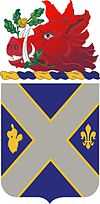2nd Battalion, 121st Infantry Regiment
| 2nd Battalion, 121st Infantry Regiment | |
|---|---|
|
121st Infantry Regiment coat of arms | |
| Active | 1810 – present |
| Country | United States |
| Allegiance | State of Georgia |
| Branch | Army National Guard |
| Type | Infantry |
| Role | Light |
| Size | Battalion |
| Part of | 48th Infantry Brigade Combat Team |
| Garrison/HQ | Forsyth, Georgia |
| Nickname | Warriors |
| Engagements | Seminole War, Mexican-American War, Civil War (Confederate Service), World War I, World War II, Iraq Campaign, Afghanistan Campaign |
| Decorations | Meritorious Unit Commendation, Presidential Unit Citation |
| Commanders | |
| Current commander | LTC Anthony Fournier |
| Command Sergeant Major | CSM Scott Turner |
| Insignia | |
| 121st Infantry distinctive unit insignia |
 |
The 2nd Battalion, 121st Infantry Regiment is a light infantry battalion of the 48th Infantry Brigade Combat Team (IBCT), Georgia Army National Guard. The Battalion is one of the oldest units in the U.S. Army, tracing its lineage to Georgia state militia units formed between 1810 and 1825. The Battalion provides the 48th Brigade with mounted and dismounted maneuver assets to destroy enemy formations in close combat. Prior to 2007, the unit was designated as a heavy mechanized formation and equipped with M2 Bradley Fighting Vehicles.
Pre-World War I
The earliest units associated with the 2nd Battalion, 121st Infantry were the Albany Guards and Barnesville Blues of the Georgia State Militia. These units, formed in 1810 along with the Baldwin Blues and Floyd Rifles, were the first organized infantry militia units in the state. In 1825, the Macon Volunteers also organized. Detachments of these infantry units served in the Seminole War and the Mexican War. During the American Civil War, the regiment was organized as the 4th Regiment Georgia Volunteers, 3rd Georgia Battalion, and finally the 37th Georgia Regiment. Units fought in most major battles of the war, including Malvern Hill, Sharpsburg, Spottsylvania, the Battle of Gettysburg, Second Manassas, Richmond, Seven Pines, Mechanicsville, Cold Harbor, the Wilderness Campaign, and Appomattox.
During the post-Reconstruction period several other regional units were added to the rolls, and by 1891 the regiment had organized into two battalions under the banner of the Second Georgia Infantry Regiment. In 1898, the Barnesville Blues fought as Company F, 2nd Battalion, 2nd Georgia Infantry Regiment during the Spanish-American War. During the Militia Act reorganization of the army in 1916, the 2nd Georgia became the 121st Infantry Regiment of the 31st "Dixie" Division.
World War I and Inter-war Years
As war loomed in Europe, 2nd Battalion, 121st Infantry was federalized to patrol the border with Mexico. In 1916 and 1917, elements rotated between the southern border, Georgia and Florida. It is this duty that the prickly pear on the left of the Distinctive Unit Insignia represents.
In September 1918, the entire regiment was ordered to duty in World War I. They arrived in France in October, and before the regiment disembarked, tragedy struck. Longtime commander COL J. A. Thomas, the man responsible for the regimental title "The Old Gray Bonnets", died aboard ship. The news didn't get any better for the tight knit unit once ashore as most of the unit was broken up into small replacement groups and sent immediately to the front. However, F Company of 2nd Battalion, along with B and C Companies of the 1st Battalion had travelled to Europe separately and were assigned intact to the 151st Machine Gun Battalion of the 42nd (Rainbow) Division. Elements of the regiment were to participate in six separate campaigns during their brief service in the war, garnering several individual citations of valor. This service is represented by the fleur-de-leis in the left side of the unit's DUI.
Upon return from France, the units were reorganized several times. In 1925, while at summer encampment at Tybee Island, GA, a hurricane struck. The National Guard camp was completely flooded and had to be rebuilt by men of the battalion. In 1934, labor unrest struck the textile mills of Georgia and 2nd Battalion was again called up, this time for state duty. Once state troops became involved in the labor troubles, they quickly died down with little violence.
In 1938, with war again threatening Europe, the massive Mississippi Maneuvers were conducted by the U.S. Army at Camp Shelby, MS. 2nd Battalion was one of the units involved. In 1940, as war seemed more inevitable, the Army developed an even larger exercise, the Louisiana maneuvers. Upon completion of that assignment, the entire regiment was federalized on 16 September 1940 at Ft. Jackson, SC and assigned to the 30th Division.
World War II
The 2–121 Infantry saw extensive activity leading up to World War II and extensive action during WWII.
From 1990
The Battalion was federalized for Desert Storm as part of the 48th Infantry Brigade on 30 November 1990. It arrived at Fort Stewart on or around 3 December 1990. After certifying at the National Training Center as combat-ready, the whole brigade was demobilised between 27 March and 10 April 1991.[1]
The Battalion then deployed to Bosnia and Herzegovina for Stabilization Force (SFOR) Rotation 9 to provide support operations for Task Force Eagle (United States contingent to United Nations Operations in support of Dayton Peace Accord). The SFOR9 rotation was scheduled from April to October 2001.
The Battalion mobilized as a component of the 48th Brigade Combat Team in 2004 for War on Terror combat operations. In May 2005 the unit began deploying to Iraq as part of Operation Iraqi Freedom and experienced some of the fiercest combat actions in the campaign. During the first half of the brigade's deployment to Iraq (Spring 2005 through Spring 2006), the 2–121st spent much of its time of the region of Baghdad while the sister units 1–108 Armor was in the Southwest region (triangle of death). The unit's focus shifted during the second half of the deployment to a theater security mission primarily consisting of convoy escort and civilian military operations. 2–121 suffered eight fatalities while deployed to Iraq. On 20 April 2006, at Ft. Stewart, members of the 2–121st returned home after a year of combat operations in Iraq.
As a part of the United States Army's ongoing transformation to a lighter, more modular force the 2nd Battalion, 121st Infantry was re-designated as light infantry in 2007. The unit gave up its M2 Bradley Fighting Vehicles and became a dismounted force, with its anti-armor (Delta) company receiving up-armored HMMWVs.[2]
In December 2007, the Georgia National Guard's 48th Infantry Brigade Combat Team was alerted that it would be deployed to Afghanistan in the summer of 2009 for Operation Enduring Freedom (OEF).[3] In January 2009, the 2–121st began training for the expected year-long deployment.[4] In the Spring of 2009, the unit returned to Camp Shelby, MS, the site of its World War II preparations nearly 70 years prior. The unit was subsequently deployed to Afghanistan in May.
While deployed in Afghanistan, the 2–121st participated in training the Afghan National Security Forces while conducting counter insurgency operations in the North, East, and Kabul Regional Command areas of operation. In April 2010 the unit redeployed from Afghanistan and demobilized at Fort Stewart, GA. The battalion suffered 2 fatalities while deployed to Afghanistan.
Current Organization
- Headquarters and Headquarters Company (Huron), located in Forsyth, GA
- A Company (Apache), located in Griffin, GA
- B Company (Blackhawk), located in Newnan, GA
- C Company (Comanche), located in Cordele, GA and Americus, GA
- D Company (Dakota), located in Valdosta, GA
- F Company (Fox), 148th Brigade Support Battalion Forward Support Company, located in Albany, GA (attached)
Lineage and honors
Campaign streamers
Seminole Wars
- Seminole (1835–1842)
Civil War
- Peninsula (1862)
- Fredricksburg (1863)
- Gettysburg (1863)
- Appomattox (1865)
World War I
- Champagne-Marne (1918)
- Aisne-Marne (1918)
- St. Mihel (1918)
- Meuse-Argonne (1918)
- Lorraine (1918)
- Champagne (1918)
World War II
- Normandy (1944)
- Northern France (1944)
- Rhineland (1944–1945)
- Ardennes-Alsace (1944–1945)
- Central Europe (1945)
Global War on Terror
Iraq: (2005–2006)
- Transition of Iraq
- Iraqi Governance
Afghanistan: (2009–2010)
- Consolidation II
- Consolidation III
Unit decorations
- French Croix de Guerre with Palm (France – 1944)
- Presidential Unit Citation (Hurtgen Forest – 1945)
- Meritorious Unit Citation (European Theater – 1945)
- Luxembourg Croix de Guerre (Luxembourg – 1945)
- Meritorious Unit Citation (Afghanistan – 2010)
References
- ↑ Thomas D. Dinackus, 'Order of Battle: Allied Ground Forces of Desert Storm,' chart 10-3 footnote 10.
- ↑ 48th IBCT soldiers transform from heavy armor to light infantry at annual training
- ↑ "Five Guard brigades notified of 2009 deployments". Stars and Stripes. Retrieved 22 November 2014.
- ↑ "A local unit trains at Fort McClellan before Afghanistan". My Web Pal. Retrieved 22 November 2014.
